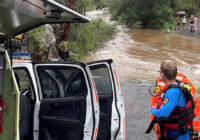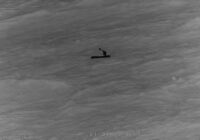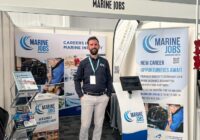Western Australia’s capabilities in marine science and fisheries research have been bolstered through the introduction of a purpose-designed and built research vessel.
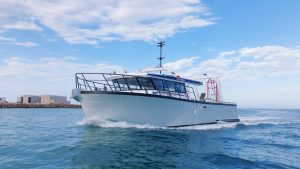
Built for the Australia state’s Department of Primary Industries and Regional Development (DPIRD) by Geraldton-based shipbuilder Dongara Marine, the new 18.6 metre fisheries research vessel (RV) was named Djildjit Kaartadjiny in consultation with Noongar (indigenous) elders; Djildjit Kaartadjiny, meaning knowledge and understanding of aquamarine fish or fisheries research.
Acquired to undertake fisheries research and science activities throughout Western Australian waters, the new vessel replaced DPIRD’s ageing RV George Cassels.
Compared to that craft, the new 18.6 metre aluminium monohull provides a larger multi-purpose research platform to perform a broad range of research, stock assessment and science monitoring tasks.
It can manage a variety of specialised research equipment including fish traps and crustacean pots, baited remote underwater video (BRUVs), remotely operated vehicles (ROVs) and towed underwater survey cameras.
Developed by Southerly Designs and Dongara Marine using the South Australian commercial fishing boat Raging Bull delivered in 2021 as a basis, the RV Djildjit design features a low profile, extended wheelhouse forward of an expansive aft work deck that is equipped and arranged to support these diverse operational needs.
This includes an A-frame, deck crane, pot winch and pot tipper. The deck structure and hydraulic systems also enable DPIRD to fit other deck equipment such as trawl/wire drum winches and longline drums when research needs require.
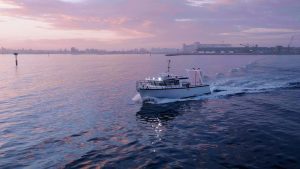
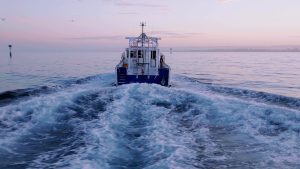
Tender vessel support
The hydraulically operated A-frame was custom designed and manufactured to enable deployment of heavy equipment and nets weighing up to three tonnes. Also fitted at the transom is a folding stern launch and recovery ramp, which can be removed when not required.
“Along with the generous clear deck length and width, this stern launch arrangement provides RV Djildjit with the capability to deploy and retrieve a variety of auxiliary vessels up to six metres in length,” explained Dongara Marine’s Managing Director Rohan Warr.
Extensive electronics package
While there is an external control station, the main helm is in the port aft quarter of the raised wheelhouse. As expected for a research vessel, the electronics package integrated by Geraldton Marine Electronics is comprehensive, as is reflected by the three 19-inch Simrad displays in the main console sitting alongside a 16-inch Furuno TZT3 multi-function display.
Central to the system is a navigation computer running TimeZero Professional system complete with MaxSea charts and the Personal Bathymetry Generation (PBG) module which enables 2D and 3D depth information to be collected and recorded in real time.
Underwater tools include a Furuno BBDS1 bottom discrimination sounder and Furuno DFF-3D multi beam sonar. The Furuno TZT3’s internal 1kW fish finder is boosted to 2kW/3kW using a Furuno DI-FFAMP “Deep Impact” Tru Echo CHRIP fish finder amplifier. The primary transducer is an Airmar CM111 2KW wide beam, low-high frequency unit.
The Furuno DRS4D-NXT solid state doppler ultra high definition radar provides coverage out to 48 nautical miles, while a Furuno SCX-20 quad antenna satellite compass provides highly accurate speed, heading, pitch, roll and heave information.
Also fitted are a Simrad A2004 autopilot, Furuno FA-70 AIS, and Furuno GP-39 GPS.
Communications are covered by an Icom VHF radio, Iridium satellite phone, Cel-Fi Go mobile phone signal repeater/booster, and a Starlink system for internet access.
Geraldton Marine Electronics also developed and integrated the vessel’s Maretron onboard monitoring and control system, and supplied and installed a 120WX Airmar WeatherStation. A Vision Pro CCTV system is fitted for visual monitoring around the vessel, with a Precision Vision IP68 rated camera fitted for monitoring anchor recovery.
The wheelhouse’s starboard side has mess / seating area for up to seven people.
“The ability to seat the full expected complement in the wheelhouse, even for day operations, provides better transit conditions for personnel; the ability to conduct briefings / meetings for all onboard in a sheltered, comfortable environment; and means all personnel can dine and relax together when not working,” Warr said.
A Fusion MS-RA55 marine entertainment system and Samsung television are fitted.
The adjacent galley features comprehensively equipped with name brand appliances including Bosch induction cooktop, Fisher & Paykel drawer dishwasher, Westinghouse fridge / freezer and Samsung 45 litre microwave. This continues below deck where amenities include an Electrolux washer-dryer, Bosch hot water service, and Haier chest freezers.
Stairs down from the wheelhouse lead to the sleeping accommodation. Spread across three areas, including a dedicated Master’s cabin, this provides a total of five berths. While the vessel will typically be operated by two crew, the accommodation spaces and facilities meet Australian Maritime Safety Authority NSCV Accommodation Level (AL) 72+ requirements enable up to four people to be onboard for unlimited durations. Larger complements can be carried for shorter duration voyages; up to two crew and six additional personnel for day trips.
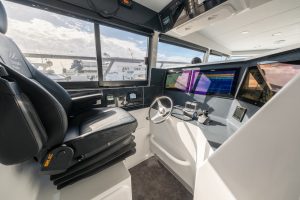
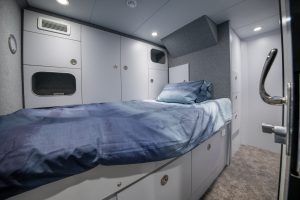
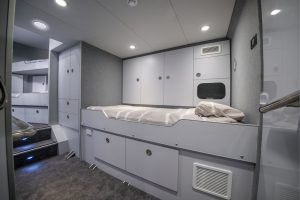
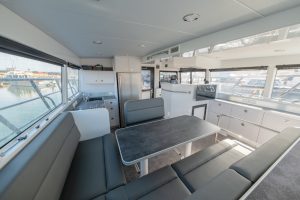
Habitability focus for long range operations
As DPIRD expects RV Djildjit to operate for up to 15 days at sea at a time, Warr said Dongara Marine devoted significant time and resources to ensure comfort and convenience for those onboard.
“In addition to finishes and fittings that would be considered exceptional in most work boats, a range of specific features enhance habitability. These include maximised use of all spaces, including extensive storage throughout; excellent natural and artificial lighting; a high capacity water-cooled marine air conditioning system from Webasto with separate self-contained units for the wheelhouse and lower deck accommodation; and application of noise abatement materials to produce very quiet living and working spaces,” he said.
To support extended voyages the research vessel has tanks for 7600 litres of fuel – expected to provide a range above 800 nautical miles at 16 knots – and 500 litres of fresh water. This is supplemented by up to 130 litres per hour from an Idromar Mini Compact Junior watermaker. Tanks aft on each side, accessed through the deck, are dual purpose: mostly used to containerised fuel for the auxiliary vessel’s outboards, they are also plumbed for use as live tanks for rock lobster.
Dongara Marine said it offered the vessel with a range of different engine options, with DPIRD electing to proceed with a single MAN D2862 LE426 diesel rated at 1140 kW and driving a fivebladed Veem propeller through a ZF 3000 gearbox.
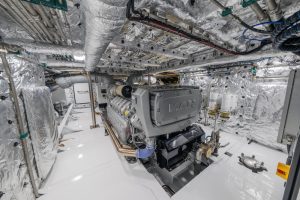
During trials the loaded vessel achieved a full power speed of 24.5 knots and cruised comfortably and economically at 18.5 knots. According to Warr both these speeds exceeded the operational requirements expressed in the Request for Tender. The gearbox is fitted with trolling valves to support extended low speed operation.
Also drawing on the fuel is a 31kVA Mase Mariner 3000 generator set. A substantial solar panel array is also fitted on the wheelhouse roof to supplement electrical power generation capability.
Dynamic positioning capability
With manoeuvring and precise positioning being important for research work, RV Djildjit is fitted with a large rudder and two Sleipner side thrusters: an SH320 forward and SH240 aft.
An AVENTICS Marex 3D three-axis joystick system enables simultaneous, integrated control of the main engine and both thrusters through joysticks fitted at both main and external helm positions. With the system in 3D mode the vessel can be steered in any direction simply by pushing or turning the joystick. The Marex OS control system coordinates the drives and holds the heading by compensating for the yaw caused by wind or current. If necessary, the heading can be easily changed by rotating the top part of the joystick.
“The system also enables direction and/or position to be automatically maintained at the push of a button, providing a dynamic positioning / virtual anchor capability,” Warr explained.
Alternatively, the thrusters and engine can be controlled separately using thruster mode.
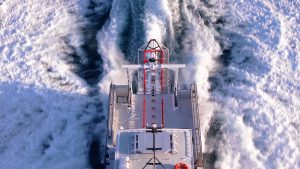
A full Humphree active ride control system is fitted, with HE series interceptors providing a 50 per cent more lift force than standard interceptors for greater control. The Professional Plus function pack provides maximum functionality adding roll stabilisation, coordinated turn, and Vessel Motion Monitoring (VMM) to the standard automatic list and pitch control capabilities. To allow for potential future upgrades, Dongara Marine fitted the vessel for, but not with, a gyrostabiliser.
RV Djildjit will be used to survey and monitor the health of Western Australia’s valuable fisheries including Western Rock Lobster, crabs, and demersal fish to support sustainability and accreditation through the Marine Stewardship Council.
The boat’s versatility also allows it to be used to support the Shark Monitoring Network and Statewide Fish Aggregating Devices (FADs) program, as well as projects undertaken by DPIRD research partners.
In survey for operations up to 200 nautical miles offshore, the research vessel will operate throughout Western Australian waters. Its first voyage was off the Mid West coast, where researchers used BRUVs and ROVs to support the West Coast Demersal fishery recovery.
Among several projects underway at Dongara Marine are three more vessels for DPIRD. In September 2023 the shipbuilder was awarded the tender to design and build a new 25 metre patrol boat to replace DPIRD’s ageing PV Walcott. That project, which includes the construction of a RIB sea boat, is expected to be completed in the second half of 2025. A new trailer boat, purpose designed and equipped for fisheries research, is on track for delivery to DPIRD later this year.
Specifications
Project type – Newbuild
Client – Department of Primary Industries and Regional Development (Western Australia)
Vessel Type – Research Vessel
Hull type – Monohull
Designer – Southerly Designs
Construction materials – Aluminium hull and superstructure
Survey / Class – Australian Maritime Safety Authority (AMSA) National Standard for Commercial Vessels (NSCV) 2B
Length overall – 18.6 metres
Beam – 5.5 metres
Draft – 1.8 metres
Capacity – 6 special persons, up to 5.5 tonnes deck cargo, ≤6.0 metre auxiliary vessel, 2 x 680 litre live tanks
Crew – 2
Fuel – 7600 litres
Fresh water – 645 litres
Main engines – 1 x MAN V12-1550 / D2862 LE426
Main engine rating – 1 x 1140kW
Gearboxes – 1 x ZF 3000A
Propulsion – 1 x Veem Veemstar 5-bladed propeller, 1.0m diameter
Maximum speed – 24.5 knots
Service speed – 18.5 knots
A-frame – Dongara Marine custom. 3.0 tonne SWL
Crane – Maxilift ML 330.3
Tender vessel – up to 2.5 tonnes (client supply)
Watermaker – Idromar MC2J
Sewage treatment – Sani-Loo





